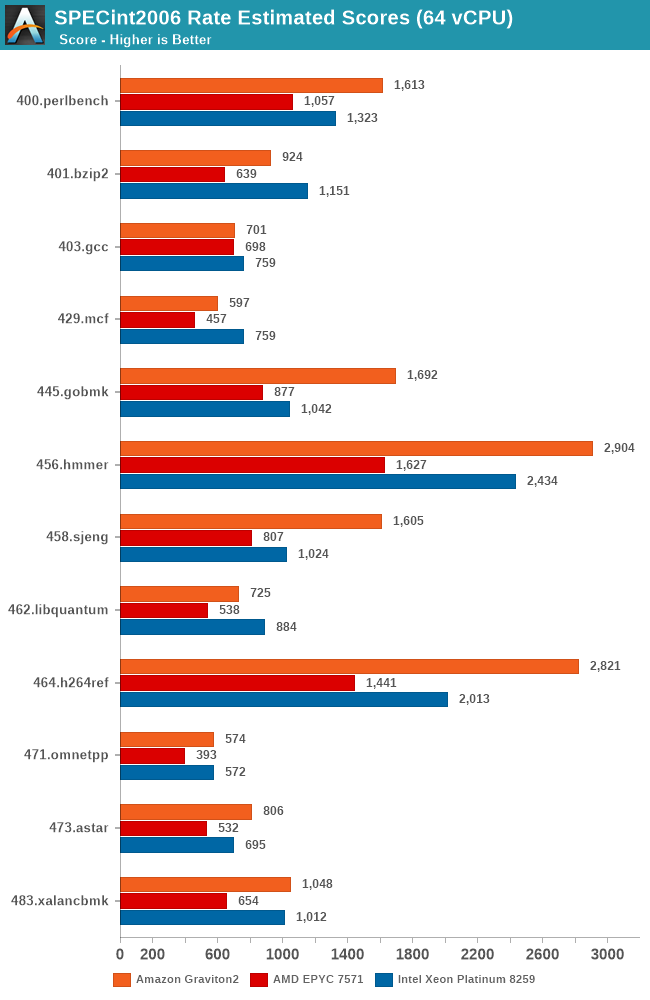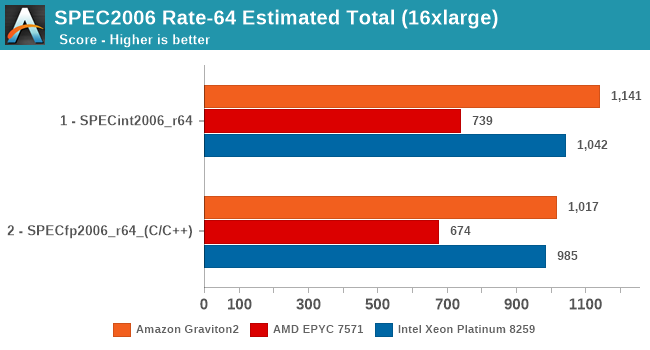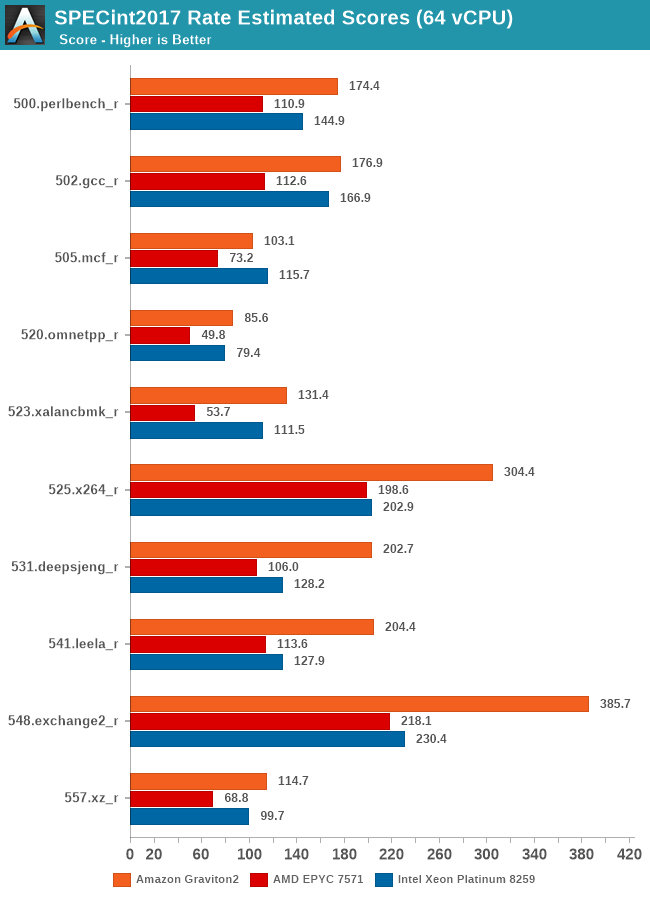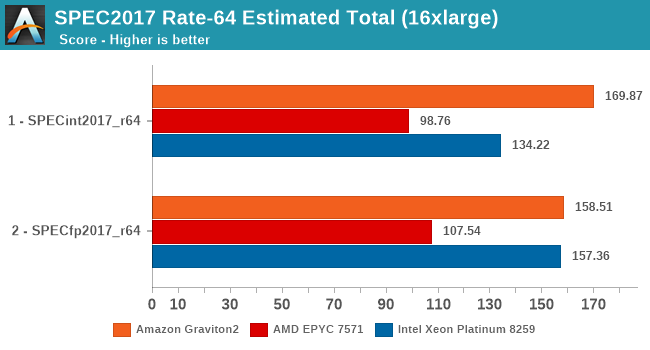Amazon's Arm-based Graviton2 Against AMD and Intel: Comparing Cloud Compute
by Andrei Frumusanu on March 10, 2020 8:30 AM EST- Posted in
- Servers
- CPUs
- Cloud Computing
- Amazon
- AWS
- Neoverse N1
- Graviton2
SPEC - MT Performance (16xlarge 64vCPU)
While the core scaling figures are interesting from an academical standpoint, what’s even more interesting is seeing the absolute throughput numbers compared to the competition. We’re starting off with SPECrate results with 64-rate runs, fully utilising the vCPUs of the EC2 16xlarge instances.
Again, there’s the conundrum of the apples-and-oranges comparison between the Graviton2’s 64 physical cores versus the 32 cores plus SMT setups of the AMD and Intel platforms, but again, that’s how Amazon is positioning these systems in terms of throughput capacity and instance pricing. You could argue that if you can parallelise your workload above a certain amount of threads, it doesn’t matter on whether you can achieve the higher throughput through more cores or through mechanisms such as SMT. Remember, when talking about silicon die area, you could at minimum probably fit 2 N1 cores in the same area than an AMD Zen core or an Intel core (probably an even higher number in the latter comparison).

The Graviton2’s performance is absolutely impressive across the board, beating the Intel Cascade Lake system by quite larger margins in a lot of the workloads. AMD’s Epyc system here doesn’t fare well at all and is showing its age.

It’s particularly in the non-memory bound workloads that the Graviton2 manages to position itself significantly ahead, and here the advantage of having a two-fold physical core lead with essentially double the execution resources shows its benefits.

In the overall SPECrate2006 results, the Graviton2 is shy of Arm’s projection of a 1300 score, but again the Amazon chip does clock in a bit lower and has less cache than what Arm had envisioned in their presentations a year ago.
Nevertheless, the Graviton2 has the performance lead here even against the Intel Cascade Lake based EC2 instances, which is quite surprising given the latter’s cost structure, and indicator of what to come later in the cost analysis.

Arm’s physical core count advantage here continues to show in the execution intensive workloads of SPECint2017, showcasing some very large performance leads in many workloads. The performance leap on important workloads such as 502.gcc again isn’t too great over the Intel system for example – Amazon and Arm definitely could do better here if the chip would have had more cache available.

In SPECfp2017, there’s more workloads in which the Xeon system’s 2-socket setup with a 50% memory channel advantage does show up, able to result in more available bandwidth and thus give the more memory intensive workloads in this suite a good performance advantage over the Graviton2 system. Still, the Arm chip fares very competitively and does put the older AMD EPYC processor in its place, and yes again, we have to remind ourselves that things would be quite different here if we’d be able to include Rome in our charts.

Overall, the Graviton2 system has an undisputed lead in the SPECint2017 suite, whilst just edging out on average the Xeon system in the FP suite, only losing out in situations where the Xeon’s higher memory bandwidth comes at play.










96 Comments
View All Comments
SarahKerrigan - Tuesday, March 10, 2020 - link
That single-thread performance is extremely impressive. The multithreaded scaling is ugly, though. Back when N1 was announced, ARM seemed to think 1MB/core was a good spot for Neoverse LLC - I wonder why both Graviton and Altra are going for considerably less.shing3232 - Tuesday, March 10, 2020 - link
it's gonna costly(die and power wise) to build a interconnect for 64C with good performance. by the time, it would lost its power/perf edge I suppose.Tabalan - Tuesday, March 10, 2020 - link
Scaling might not be optimal, but performance loses are to expected if you greatly reduce available cache. In the end, MT performance is still far ahead of competition.ballsystemlord - Thursday, March 12, 2020 - link
You have to remember that the competition is not 64 cores, but 64v cpus. The difference is 60% or more. The Arm Graviton2 is being placed into the best possible light by this comparision.ballsystemlord - Thursday, March 12, 2020 - link
I mean 60% for the cores that are actually 1 thread. As in, the performance boost by turning on SMT is 40% best case scenario.autarchprinceps - Sunday, October 25, 2020 - link
I have to disagree. You seem to forget that the arm chip is cheaper. It’s an additional win if it manages to integrate more cores and yet still achieve a comparable single threaded performance. It’s not unfair to compare two products with one seeming to have a stat advantage from the start, if it’s still cheaper or costs the same. Why should a customer care?zamroni - Thursday, March 12, 2020 - link
L caches uses sram which needs 6 transistors per bit.So, every 1MB needs all least 48 millions transistors without counting transistors for the controller
dianajmclean6 - Monday, March 23, 2020 - link
Six months ago I lost my job and after that I was fortunate enough to stumble upon a great website which literally saved me• I started working for them online and in a short time after I've started averaging 15k a month••• icash68.coMRallJ - Tuesday, March 10, 2020 - link
Comparisons made are to the whole core performance of Graviton to just thread performance of Xeon/EPYC. It's very problematic.Also TDP rating for the graviton is off by 50% based on what was reported at re:Invent.
Andrei Frumusanu - Tuesday, March 10, 2020 - link
I go over the core/SMT topic in the article, it's only a problem from a hardware comparison aspect, but it's very much the correct comparison from a cloud product offering comparison. The value proposition also does not change depending on core count, the instances are priced at similar tiers.